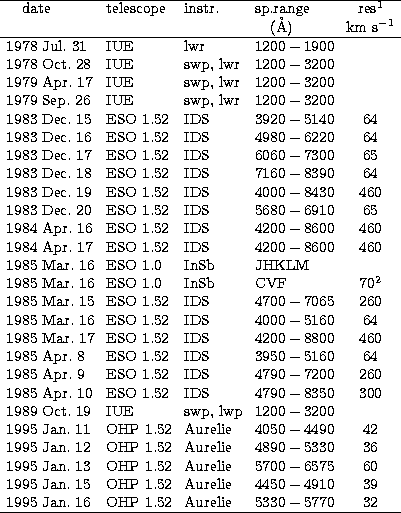 |
 |
Infrared data were obtained only in March 1985.
For the photometric observations the integration time
ranged from 1 to 2 min,
depending on the filter and on the selected signal to noise ratio.
Narrow band spectrophotometric observations were performed on
the same night with the
Circular Variable Filter in the
1-5 ![]() m region. The integration time for each
band was of 50 s, and the full wavelength range was scanned in 82 min.
The S/N ranges from 8 to 60.
m region. The integration time for each
band was of 50 s, and the full wavelength range was scanned in 82 min.
The S/N ranges from 8 to 60.
The optical spectrum of V 380 Ori was monitored at the 1.52 m ESO telescope with the B&C spectrograph and IDS detector on several different epochs between December 1983 and April 1985. In each observing run several spectra were taken with different dispersions from 59 to 224 Å mm-1 in order to have both the details on the lines and the energy distribution for the whole spectral range of the instrument. The March 1985 spectroscopic observations were made simultaneously to the infrared observations. The observational data were calibrated using spectrophotometric standard stars. The April 1984 observations were obtained in bad weather conditions; the absolute flux calibration resulted of poor quality with different continuum levels from diffent exposures and different standard stars. The IDS spectra were reduced in Garching using the IHAP software package. In the ESO spectral images for the sky background correction we have taken the sky very close to the star so that also the emission from the nearby nebulosity has been subtracted.
More recently, in January 1995, we made new observations with the Aurélie spectrograph attached to the Coudé focus of the 1.52 m telescope of the Observatoire de Haute Provence, in order to provide spectrograms with a resolution high enough for the study of the line profile, and for an accurate line identification. During this run the observations were disturbed by very windy weather conditions which did not allow us to obtain reliable absolute fluxes. The problem of the calibration of these observations will be discussed in Sect. 3.2.
The S/N measured in wide "continuum'' regions in all the optical spectra ranges from about 40 to more than 100. But the actual S/N is larger because the quoted values are to some extent affected by the presence of weak spectral lines.
Within this program, the ultraviolet spectrum of V 380 Ori was obtained with the International Ultraviolet Explorer (IUE) at the ESA Villafranca Tracking Station on 1979 September 26 in the low resolution mode in both the short and long wavelength ranges. In addition, we have retrieved from the IUE archive all the other low resolution UV spectra taken in the period 1978-1989. All the IUE spetra used are listed in Table 1.
Copyright The European Southern Observatory (ESO)